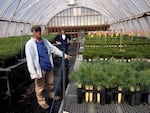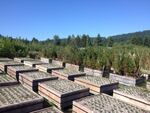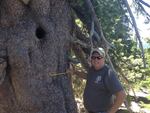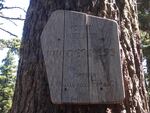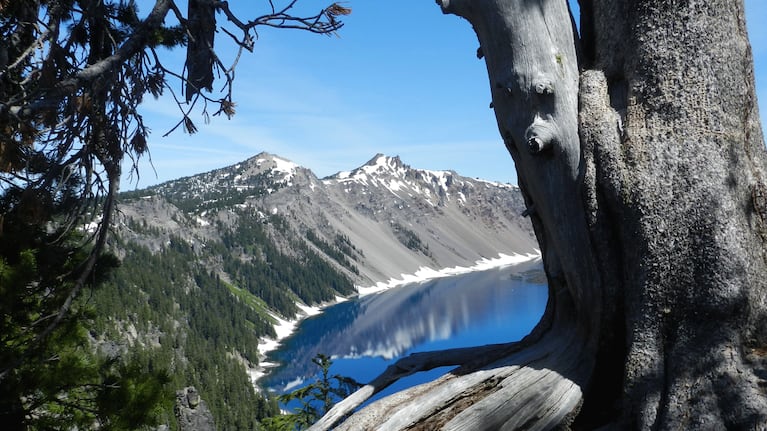
A dying whitebark pine in Crater Lake National Park. The National Park Service is planning to plant disease-resistant varieties in its wilderness zones but the Forest Service says the Wilderness Act prevents it from doing so in its wilderness areas,
Amelia Templeton / OPB
This is the second part of a three-part series on the 50th anniversary of the Wilderness Act. Read Part I here.
COTTAGE GROVE, Ore. -- If you want to see a whitebark pine up close, be prepared for a hike. These trees thrive at high elevation, where the terrain is often too high up and the climate too extreme for most plant species.
That's why scientists consider the whitebark pine to be a keystone species. Birds nest in their cavities. Their prickled cones produce a fatty seed favored by squirrels and bears. Their branches filter sunlight for certain wildflowers and their roots stabilize soils on steep slopes.
Over 80 percent of whitebark pines growing in West Coast states are found in wilderness areas. And thanks to the Wilderness Act, signed 50 years ago Wednesday, much of the whitebark pine's habitat is protected.
But the Wilderness Act has not been enough to stave off the threat of extinction for the Whitebark pine -- a threat that scientists say is being hastened by climate change.
Richard Sniezko
As average temperatures elevate in alpine zones, pests and diseases are taking hold and wildfires are a growing threat.
One of those diseases is blister rust, which causes cankers to form.
“You can have hundreds of cankers per tree or you can have one canker per tree," said geneticist Richard Sniezko. "If that one canker’s in the right place, it can kill the whole tree. In some areas, you can probably have 90 percent or more of the trees maybe killed by blister rust.”
Sniezko works at the
Russell OakesDorena Genetic Resource Center, a Forest Service lab located at the southern end of Oregon's Willamette Valley. Whitebark pine saplings grown here are infected with blister rust to check for resistance. Those saplings that are able to resist the disease can then be planted back in the wild.
Russell Oakes
That’s the idea, anyway.
But there’s one thing standing in the way: The Wilderness Act of 1964.
“Wilderness areas have limitations on what we can do. It limits some of the restoration activities,” said Russell Oakes, a Forest Service silviculturist with the Forest Service who is working to save the whitebark pine.
The Forest Service has determined the Wilderness Act doesn’t allow for the planting of these disease-resistant whitebark pines in wilderness areas.
“We’ve gone back and forth within the agency about whether we can or not. Right now, (it's) no,” he said.
The issue came to a head last year in the Okanogan-Wenatchee National Forest in north-central Washington.
Entomologist Connie Mehmel proposed planting whitebark pines in a portion of the Pasayten Wilderness that was ravaged a decade ago by wildfire.
“We’ve got the old whitebark pine skeletons out there but none have come back,” she said.
Mehmel didn't expect opposition from conservationists. But a group called Wilderness Watch came out against it – and it was taken off the table.
Board member Gary Macfarlane wrote the comments.
“This is gardening, it’s manipulation of wilderness," he said. "And wilderness is the one place that we made a decision as a society to let nature roll the dice – regardless of whether we think those dice are loaded or not.”
Listen to an audio report:
The Wilderness Act defines wilderness as areas "where the earth and its community of life are untrammeled by man, where man himself is a visitor who does not remain."
And Mehmel concedes that planting on wilderness could indeed cross that line.
“It really is trammeling the wilderness," she said. "As we go about the process of planting trees, even for restoration, there’s controversy associated with that. This probably wasn’t the place and time, the controversy was really too great. We need to settle these issues of how we’re going to manage whitebark pine in wilderness before we take on a project like this.”
At Southern Oregon's Crater Lake National Park, there is more flexibility when it comes to whitebark pine restoration.
- READ Scientists Scramble to Save Crater Lake’s Whitebark Pine
Half of their whitebark pines are within the boundaries of wilderness areas proposed for the park, according to botanist Jen Beck
“The Forest Service is interpreting planting for restoration as trammeling of the wilderness," she said. "Whereas, I believe the Park Service considers trammeling being human-caused impacts — the introduction of a non-native disease, white pine blister rust, that has led to the demise of a whole ecosystem.”
Wilderness is meant to be a place free from human disturbances. But, as Beck contends, blister rust is the consequence of a manmade disturbance; and it’s one that should be combated through planting disease-resistant whitebarks.
“We’ve conducted four park-wide restoration plantings to date, we’ve planted about 1,000 seedlings. So far, none of those have been within wilderness, but it’s definitely on the table,” she said.
The story of the whitebark pine is, in some ways, the story of how the Wilderness Act has been unable to prevent human-caused trammeling of nature that’s been playing out on a global scale: Climate change.
Whitebark pines thrive in chilly mountain weather. Beck said warming temperatures are allowing disease and pests like beetles to thrive at the higher elevations where the tree had once been safe.
“The forecast isn’t very rosy. We consider it such an important species that we definitely do not want to see it disappearing from Crater Lake," Beck said. "So we’ll do what we can to keep it around.”
Government biologists say the whitebark pine deserves federal protection — but higher priority species have created a backlog that could last through 2017.
But that won't necessarily get conservationists like Wilderness Watch's Macfarlane on board with solutions that include planting trees in wilderness areas.
“That’s the idea of wilderness," Macfarlane said. "We’re going to use a little bit of humility and restraint in these areas.”
There’s more in our series on 50 years of wilderness.
Tuesday: The legacy of the Wilderness Act
Wednesday: How humans are altering wilderness through climate change
Thursday: Why it’s harder than ever to create wilderness

